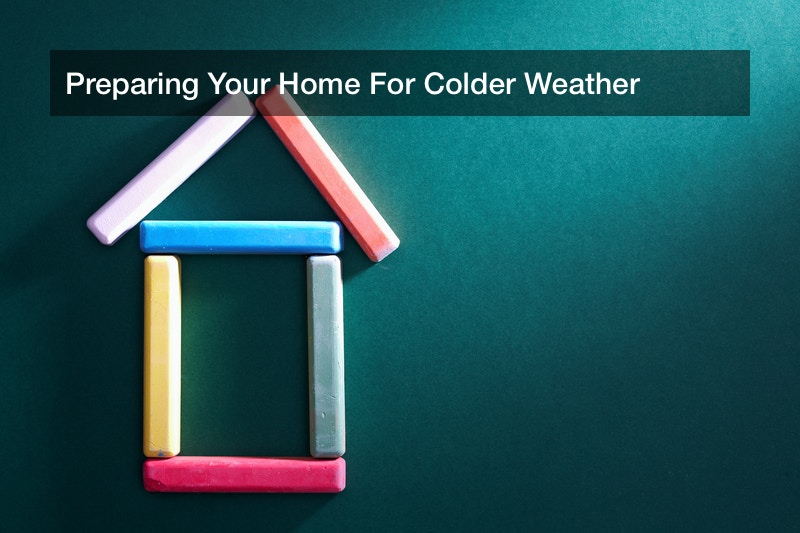
After all the fun you had this summer, running the air conditioning, having backyard BBQs and enjoying time outside, it’s time to prepare your home for what comes next.
There’s a lot to like about fall and winter, but by failing to prepare your home for both seasons, you could be dealing with a boatload of problems when all the snow has melted and spring comes.
If you’re wondering how to prepare your home for fall and winter, there are many easy steps you can take.
Let’s focus on fall preparation first.
Get Your HVAC System Checked
After a few months of running your air conditioning to beat the heat, it’s time to give your AC unit a rest. But before you turn off the air conditioning unit for the summer, and remove it (assuming it’s removable), make sure you clean it a little bit. If you have central air, which likely means you have an outdoor unit, make sure to cover it completely to keep debris such as leaves and twigs from damaging your system, especially on blustery days.
Once you’ve done that, make sure to switch your thermostat from cooling to heating. If it’s been a while since you changed the filter on your central air system, you might want to do that too. You should also make sure that all of your indoor air vents aren’t covered up and that they’re clean. That way when you’re getting heat during the winter months you’re not also breathing in dust and debris.
While you can typically get by with just checking and cleaning your filter, it may be worthwhile to have heating contractors come to your home and check your heating system. They can do a more thorough cleaning to your ductwork and inspect your chimney as well. If you have a gas or oil furnace, they can check for leaks as well that you may not have noticed. Along the same lines, depending on which furnace options for your home you have, for example, if you have an oil tank, you may want to consider buying more oil to ensure your tank is full.
Another thing you can do to prepare the heating system for the winter is to turn it on and run it in the fall months before it gets too cold. This is just a simple test for your home heating device to make sure there aren’t any unusual sounds suggesting it may need repair. However, it will be common for an unusual smell to linger the first time you run it. But, if that persists, it will be good to have a few months of time to get your home heating equipment fixed if need be.
Inspect Your Chimney
The last thing you want during fall or winter is to see your home filling with smoke and soot because your chimney isn’t working correctly. The same is true even if you have a gas fireplace. So a good move is to hire a contractor who can come and inspect your chimney or gas fireplace. You’ll likely only pay a few hundred dollars at most and you’ll save yourself from having any problems when the weather turns really cold.
Prepare Your Snow Equipment
You may not think so, but in your playbook for how to prepare your home for fall and winter, getting all of your winter equipment is near the top of the list. If you go into a store during the winter time, you may find yourself struggling to find some basic items.

A good step is to visit a store in the fall to stock up on snow gear. You can easily find snow shovels, snowblowers, and even ice melt. You don’t want to get caught with several feet of snow in your driveway and nothing to remove it with.
Get Moving
As fun as summer is, it’s imperative that you get moving when you’re preparing your home for what’s to come. If you’re thinking to yourself, “Oh I’ll just take care of it later,” think again.
Putting off preparations for fall and winter can potentially cause problems that wind up hitting you deep in the wallet. So don’t delay and make all the necessary preparations you need to keep your home safe.
Clean Your Gutters
As you learn how to prepare your home for fall and winter, you’ll learn that it’s a good idea to clean your gutters. Clogged gutters can funnel water down the side of your home where it can collect and damage your foundation. It can also flood your basement. To prevent any of that from happening, go get a ladder, climb on up, and pull all of the debris from your gutters by hand. You can also use a leaf blower attachment if you have one to blow the stuff right out of your gutters and get them clean again.
If you don’t feel like cleaning your gutters yourself or you have trouble getting up on a ladder, call local gutter services to come and clean out all the debris before the cold of winter hits.
Test Your Detectors
Studies have shown that a great deal of house fires happen in the winter. A good step in your guide to how to prepare your home for fall and winter should therefore be testing your home’s smoke and carbon monoxide detectors.
Fires can happen easily since winter is a time for turning up the heat and having fires. Carbon monoxide also becomes more of a hazard if your home is closed up tightly. You can help prevent any issues with either one by quickly checking your detectors and having spare batteries on hand if any of them need to be changed out.
All homes have at least a couple of smoke detectors, but if you don’t have any carbon monoxide detectors, it’s highly recommended that you get some.
Don’t Forget Your Lawn
Even though you probably spent all summer mowing your lawn and caring for it, you still need to take care of it in the fall. Many experts will tell you that fertilizing your lawn in the fall helps protect it during the winter and also helps it green a lot faster when spring hits.

Shut Down Your Pool
As you figure out how to prepare your home for fall and winter, don’t forget to shut down your backyard pool. Pool closings are best done by experienced contractors, who will make sure your pool is shut down correctly and your system is prepared for winter.
What do you need to do? Use the following checklist to shut your pool down.
- Vacuum around the pool and remove all debris.
- Balance the pool chemistry and make sure the pool water level is at an acceptable height.
- Remember to shock and chlorinate your pool to prevent a buildup of bacteria.
- Drain your pool lines and don’t forget to add antifreeze (assuming of course your pool is in freezing temperatures).
- Before the heart of winter hits, throw a cover on your pool to prevent debris from falling in.
- Use a test kit to periodically check your pool’s chemical balance.
Now let’s shift to prepping your home for winter.
As you’ve already read, it’s absolutely no fun trying to winterize your home when it’s already freezing outside. So here’s what you can do to get your home ready for winter.
Check Your Fuel Supply
If you live out in the country, you need to make sure that you have fuel for winter. So get your propane tank topped off or make sure you got enough fuel if you happen to have an oil furnace.
Winterize Your Pipes
If you’re a homeowner, then there’s a good chance that you’ve had to deal with a burst pipe in the springtime. If you’re a new homeowner, there’s no better way to learn the importance of how to prepare your home for fall and winter than by dealing with your home’s system of pipes.
Pipes are very susceptible to cold in the winter time and burst pipes can mean expensive repairs. Some of the most susceptible pipes are those that control the water supply.
If you have any exposed piping, such as in areas like your attic or crawlspace, then make sure they’re insulated. At the very least you can wrap them with insulating sleeves.
You should also check on your exterior faucets and make sure that they are turned off. You will need to open them up and drain the water from them. This is especially true if you have outside hoses or faucets. You need to disconnect them, drain the water, and cover them.
If you’re leaving for warmer climates this winter, then you need to make sure your entire water supply is shut off and make sure the plumbing system is drained correctly. If you have a leak, you’re likely going to be hundreds of miles away when the damage occurs and you don’t want to return to your summer home facing potentially catastrophic damage.

If you are indeed shutting down your summer home for the season, you should put a call into local plumbing services. Shutting down your water correctly and making sure it’s all drained can be very tricky if you don’t know what you’re doing. Failure to do it right can result in pipes bursting, which can lead to a vicious cycle of making endless repairs to your plumbing system.
If you do need the assistance of water pump repair services in the springtime or an experienced plumber, learn about the work they’ve done to your home so that if anything should happen in the future, you know what needs to be done.
Check The Trees On Your Property
Another important part of learning how to prepare your home for fall and winter is taking a look at the trees around your property and checking on their health. Sometimes, spotting a dying tree is obvious, but other times it’s not as simple. If you’ve got dead trees around your property, especially some that might be leaning toward your house, call a tree service to get them removed.
Get your trees trimmed before winter really arrives. If you’ve got branches that are rubbing up against your house, get them trimmed so you don’t get ice and snow-covered branches rubbing against your house’s siding or windows.
Prepare Your Roof
As winter approaches and you’re figuring out how to prepare your home for fall and winter, you need to pay special attention to your roof. It’s easy to want to sit by the fire or curl up on the couch when the snow is coming down outside, but that also means your roof is working to protect you from the elements.
Before you even have to worry about snowfall, get in touch with local roof services and get your roof prepped for the snow and cold. How do you pull this off? Follow these steps:
- The first thing you need to do is look at your roof from the ground to check for anything out of the ordinary.
- Have a professional inspect it. It’s actually recommended that you have two inspections done per year, one after the winter and one after the summer.
- Get expert opinions from your roofing contractor on what needs to be done. If you need to repair leaky roof for example, don’t hesitate to get it fixed.
Having a roof that’s ready for winter also means keeping an eye on it during winter. When snow falls, you need to know what kind of snow is falling. Light and fluffy snow is harmless, but heavy, wet snow can build up on your roof and cause problems down the road.

To avoid snow buildup, keep a snow rake handy. After a hefty snowfall, take your rake outside and use it to safely remove snow and ice. You’re not going to be able to clean the entire roof off with a rake, but you should be able to remove some of the loose snow and keep your gutters and downspouts clean.
Don’t be afraid to reach out to professionals either. If you find yourself in need of a roof repair before winter or snow removal during winter, professionals can take care of both things safely and efficiently.
Seal Your Hard Surfaces
Figuring out how to prepare your home for fall and winter may take a while to get down to a science, but one step you should also consider is protecting your home’s hard surfaces.
Just like plumbers can help protect your home’s plumbing system and water lines, those who are knowledgeable about masonry can help protect your patio, driveways, and walkways. They can apply concrete sealers to flat surfaces like patios and can also put control joints in all the right spots so that your surfaces don’t freeze and crack after the harshness of winter.
Preparation Makes Perfect
Knowing how to prepare your home for fall and winter can have an endless amount of benefits. By researching and learning, and using the expertise of contractors, you can protect your home, protect your property, and be ready for whatever fall and winter throw your way. By taking time to prep, you won’t be caught off guard, end up with unwanted surprises, or unwanted repairs.




